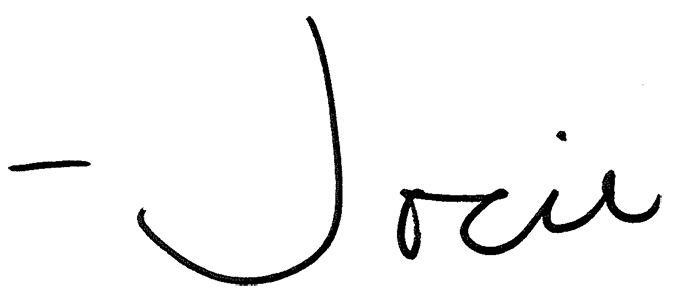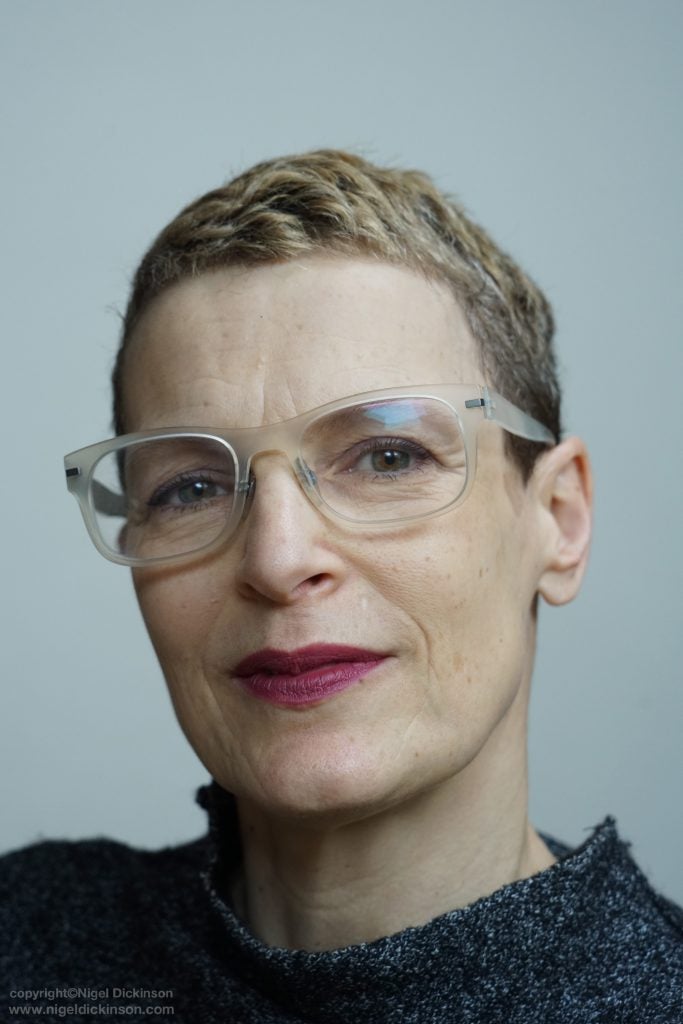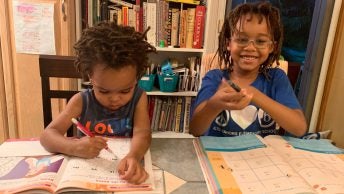I first started following Laura Godfrey-Isaacs on Twitter a few months ago, when she was starting conversations about gender language and inclusivity in birth work. Laura is a midwife, artist, and activist and brings this rich background together to help advocate for creative approaches to supporting birthing people. Laura and I recently chatted about her career, the role of creativity in birth work and research, and artists to follow. Enjoy!

Jocie: Can you start by telling me a bit about your path in this field and how you came to work at the intersection of midwifery, art, and activism?
Laura: Sure, so I originally trained as a visual artist and also worked as an academic where I was particularly focused on feminist concerns of the representation of the body. I then went on to be a creative producer, and set up and ran a company for about 10 years where we put on live art and participatory projects. So I’ve had quite a rich history in the arts. And in 2013 I decided to train to be a midwife. Having originally thought that that was going to be a completely new departure for me, I found increasingly that I was thinking about artists, and I was thinking about artistic practice in order to find ways to bring the two things together. By the time I finished training to be a midwife, I had started to carve out some of these projects using my past experience and skills as an artist but also as a producer to work particularly with women using art strategies. That has manifested in lots of ways. I’ve done projects using social media such as a “brelfie” project where we were encouraging people to share images of themselves breastfeeding with a hashtag for breastfeeding week. And then a big project I started a couple of years ago is Maternal Journal. It’s a workshop format and also an individual practice of journaling with people that are birthing using all different types of artistic practice. It’s very much about addressing mental health and wellbeing in that population. So it’s bringing people together in groups to journal and to share and support each other and also introduce them to different ways they can journal and encourage their own creativity.
Jocie: Great, thank you. As we’ve been doing this work and moving into the art world I’ve been thinking a lot about the way activism and science are sometimes thought of as being at odds with each other. And I really don’t believe that that’s true, I think they can complement each other in a beautiful way. I’d love to hear a bit about how you think about that perceived tension between science and activism in your work.
Laura: That’s an interesting question. I don’t particularly think of myself as a scientist, but as a health care professional, but I think that activism based on research is really important. I think that scientific research gives us data, it gives us information about health inequalities, about people’s experience of healthcare that’s really important. And I think as health care professionals, sometimes that research is not generalized, it’s not out there in the public domain, it sometimes just fits within an academic silo, and there is this understanding that apparently it takes on average about 17 years before research causes change in clinical practice. And so I think that in many ways, being an activist but using research that’s out there rather than supposition or working on anecdote is important and helps us get those messages out to the population and try to change practice in that way.
Jocie: Absolutely. And I was looking at your blog Birth, Art, and Culture and you said something about how there are very few interdisciplinary and creative research and clinical interventions. Do you have any examples of this kind of interdisciplinary, creative research from your career?
Laura: Research is quite new to me, my background is really in the arts. It’s hard for artists to sometimes know what research means in a scientific context. We’re hoping to do a research project with Maternal Journal because what we have is a lot of really good feedback and more qualitative feedback from people taking part in these workshops, but what we’re hoping to do is a more rigorous research project with that so we can try and put more pressure on health services to really seriously take into consideration using creative and artistic strategies. I think that it is being taken more on board in the UK. I don’t know so much about America. There was a really big political report that came out by the All Parliamentary Group on Arts, Health & Wellbeing, ‘Creative Health’ 2017, which was advocating for using creative strategies to address some of the big health issues we face such as mental health, aging, isolation, chronic conditions, pain. And so there’s quite a lot of political will around that in the UK, and research is catching up. There’s just been a big grant given through the Welcome Trust which is a big funder in the UK to look at scaling up three artistic interventions that have been piloted, and one of them is working with mothers. It’s called Melodies for Mums. It’s a singing project for women and people who birth in the perinatal period with mental health problems. It’s had some research which has been very positive and this new grant will be looking at how it’s possible to scale up those projects. Because I think going to quite a lot of conferences for instance around creative strategies in healthcare, a lot of the projects are piloted at a small scale but they haven’t had a randomized control trial and haven’t been scaled up. So things stay on a small scale. But we have a national health system, and in order to look at how those strategies could have an effect on the general population you’d need to have a higher degree of evidence and look at how you could scale up to the whole population.
Jocie: Fantastic. So using research in service of scaling creative projects that are related to health care?
Laura: Yeah, and there are a lot of artists interested in working in this context. And like I said, when I ran the company Home Live Art for 10 years, a lot of the work was with performance artists who work in a very collaborative and participatory way, so they work with the public, with the audience, with communities, using art strategies in order to encourage social connection and address isolation. Or working with communities that are marginalized but equally those strategies can be used very successfully in a health context.
Jocie: Is there any particular artist or project you’ve worked on that has stood out to you as having a great impact on maternal health?
Laura: In maternal health, one of the things I’ve been trying to get across with my work is actually there’s not very much of this work going on in a maternity context. There’s a bit of a gap there, and perhaps that’s why there’s interest in what I’m doing with Maternal Journal and other projects. So Melodies for Mums is the one that springs out at the moment because it’s the one that’s been quite visible and has this major funding. It’s exciting to look at that project and see if it will be scaled up – if it’ll be adopted by the NHS as a strategy – because maternal mental health is a really big issue in the UK as I’m sure it is in the United States as well, and I think a lot of focus goes on psychological therapies and medication but having this more psychosocial approach using creative strategies can be really successful.
Jocie: Absolutely. And something that really struck me when I was reading about Maternal Journal – and it seems like the same is true about Melodies for Mums – was that in addition to being about creativity, it also seems to be about community and bringing people together. I think creative endeavors have the power to do that, and that’s so important during pregnancy and the postpartum period when at least in the US so many people can feel isolated. I love the idea of combining creativity and community in the same space to support families and birthing people.
Laura: Definitely. I think Maternal Journal has lots of layers to it. It has the community aspect, the psychosocial support of being in a group and being part of a community. It has the creative benefits to your mental health of being engaged in creative activities. But also it’s about developing a long-term practice of journaling and engaging with our resources so you develop a practice that you take forward into your life opposed to just an intervention, and then you’re better. And also it’s interesting because it plays on the feminist tradition of journaling and keeping a diary – before women had access to being professional artists keeping a diary or journal was an acceptable way for women to write, not just creatively but also to make social and political comments. So a lot of the diaries we look at historically are important social documents from creative women who probably in our time would be journalists, writers, poets, etc. And women find it empowering to plug into that history and feel that they are part of the legacy. But there are lots of other things going on, particularly around women writing about their birth. There’s a website in the UK called ‘tell me a good birth story’. I think there’s quite interesting outlets to encourage people to write about their birth and make an account of that and having a creative but also cathartic thing to do. And there are lots of memoirs as well written by women about their experience of pregnancy and birth. We’ve collected a list of those on our website, so people can look at and access those. Because I think it’s great to look at other people’s accounts of births and motherhood because then you often recognize things you were feeling or recognizing on your own and thinking it was just you is actually part of a wider cultural framework that you’re living through and many mothers are experiencing the same.
Jocie: I loved that reading list you had on Maternal Journal. Are there one or two artists who you draw inspiration from and who you think people doing birth work should know about and look up?
Laura: Yeah, again we have inspiration on the Maternal Journal page. I find some of these journals that people have written really inspiring. The one I really love is written by a British poet, Hollie McNish. Her work is called ‘Nobody Told Me: Poetry and Parenthood’ and it’s a funny, honest, but also quite political account of her experiences as a young woman going through pregnancy and the first two years after birth. And because she’s a poet, it’s a kind of diary and also interspersed with amazing poems. And she’s gone on to convert some of those poems into really powerful films that you can access on YouTube. So I find her really brilliant, and she’s carried on writing from her own experience, and she’s a performance poet who’s really well known in the UK.
Someone else I really like is an American cartoonist named A.K. Summers. And she produced a book called ‘Pregnant Butch: 9 Long Months Spent in Drag’. And that’s a really funny and revealing graphic novel about her experiences of being a butch, feminist woman and going through this stereotypically feminine experience of being pregnant. And I think one other I might flag is another graphic novel by a British cartoonist Henny Beaumont which is called ‘Hole in the Heart: Bringing up Beth. And it’s about her experience bringing up a child with Down’s Syndrome. So she gave birth to a daughter with undiagnosed Down’s Syndrome. And this graphic novel is about how she went through this whole series of emotions, shock and then not good healthcare professionals trying to support her. And then coming out the other end being quite a political mother and fighting for the rights for her daughter to have opportunities and be treated with respect. So those are some we flag up at Maternal Journal and that I myself find very powerful.
Jocie: I’m excited to look them up! Is there anything else you’d like to share about your work or anything else you’re doing in the field?
Laura: I just think that art and creative strategies can be used in so many different ways in this context. They can be used in trainings for doctors. They’re used in medical humanities, but not so much in midwifery education, but that’s creeping in now which is great. I think they can be used for health care professionals for their own creativity and their own self care. I think they can be used obviously with the people we care for in the way we described like mental health, isolation, and social connection. And I think they can also be used to raise awareness about health disparities and how to disseminate research. So I think art and creativity can be used in all those ways really effectively which is really exciting.
Jocie: Great, thank you so much, Laura!

Laura Godfrey-Isaacs is an artist, midwife, creative producer, and birth activist. She aspires to bring her knowledge and experience in the arts to bring fresh interdisciplinary perspectives to inform midwifery education, practice, policy and research. She regularly presents at conferences, and creates interdisciplinary projects and campaigns, such as Maternal Journal www.maternaljournal.org which supports mental health and well-being through creative journaling.
Blog: https://www.all4maternity.com/caring/blog/birth-art-culture/
Twitter:@godfrey_isaacs
Website: www.lauragodfreyisaacs.com


